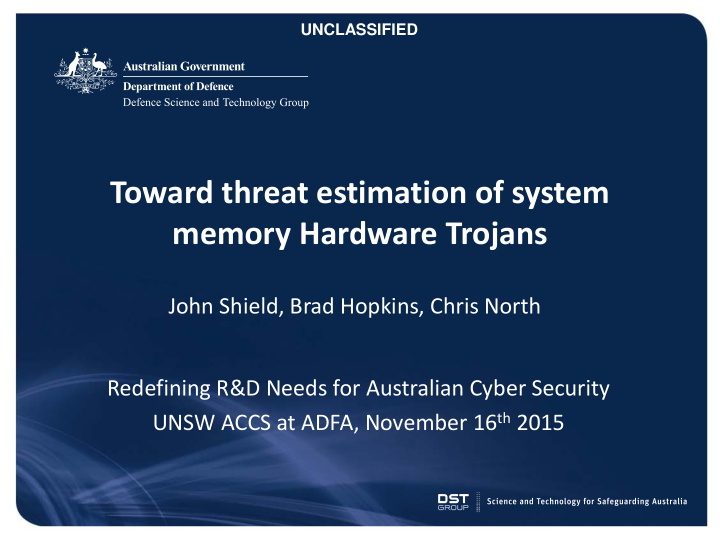



UNCLASSIFIED Toward threat estimation of system memory Hardware Trojans John Shield, Brad Hopkins, Chris North Redefining R&D Needs for Australian Cyber Security UNSW ACCS at ADFA, November 16 th 2015 1
UNCLASSIFIED The Australian Perspective Australia sources all integrated circuits from overseas Lack of resources for: – designing – fabricating – testing chips Majority of supply is from non-allied nations Gartner report "Market Share: Semiconductor Foundry, Worldwide, 2014." Vendor Foundry Location 2014 2014 Market Revenue Share (%) TSMC Taiwan 25,175 53.7 UMC Taiwan 4,621 9.9 Globalfoundries U.S. 4,400 9.4 Samsung 1 South Korea 2,412 5.1 SMIC China 1,970 4.2 2
Hardware Trojans Modifications to Circuit Boards or Integrated Circuits We Focus on Integrated Circuits – Harder to verify post-production Modifications Possible – Functional – Parametric Outcomes – Leak or Modify Information – Reduce Effectiveness • Denial of service, degradation of service, integrity attacks, etc. 3
Memory Protection Memory Protection is Key to Software Security – Privilege Levels and Data Isolation DRAM MEMORY CPU HARDWARE Redirected Blocked Memory Hardware Trojan access to Access blocked region Software MMU Valid Memory Access Normal Access Memory DRAM Mapping Mapping 4
Memory Trojan – Exemplar Hardware Interposer Card Redirects memory accesses 5
Case Study: Cloud Computing Breaking: Memory Isolation between Virtual Machines Description: Data modification of corporate email in a corporate VM using an public VM 6
Case Study: Guest Accounts Breaking: Privileged (kernel) Mode and User Mode Description: Overwriting a root executable by a guest user to gain root access 7
System Memory Trojan Threat Threat Level – High Threat: Software security hinges on memory protection Securing Procurement – Not viable Defence Mechanisms – None Commercially Available 8
Threat Mitigation Strategy DST Group – Trustworthy Systems Research – Research: Trustworthy circuit design using untrusted components – Provides Australian defence context and applications – Collaboration: Integrate external S&T and Industry Academia – Research: Trustworthy software (eg seL4) – Research: Security primitives for hardware & processors Industry - Partner early for – Technology insertion – Transition into capability 9
Recommend
More recommend